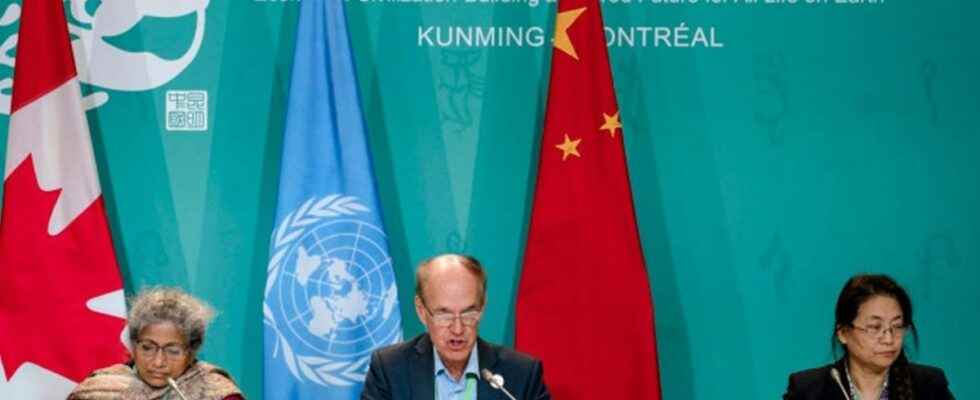Published on
Updated
Reading 3 mins.
Countries around the world adopted a historic agreement in Montreal on Monday to try to stop the destruction of biodiversity and its resources, essential to humanity.
After four years of difficult negotiations, ten days and a night of diplomatic marathon, more than 190 States have reached an agreement under the aegis of China, president of COP15, despite opposition from the Democratic Republic of Congo.
This “pact of peace with nature” called the “Kunming-Montreal Agreement” aims to protect land, oceans and species from pollution, degradation and the climate crisis.
The countries have agreed on a roadmap aiming in particular to protect 30% of the planet by 2030 and to release 30 billion dollars in annual conservation aid for developing countries.
“The agreement has been adopted”, China’s COP15 president Huang Runqiu told a late-night plenary session before dropping his gavel to the applause of tired-looking delegates.
“Together we have taken a historic step”welcomed Steven Guilbeault, Minister of the Environment of Canada, host country of the summit.
The creation of protected areas over 30% of the planet, the best known of the twenty measures, has been presented as the equivalent for biodiversity of the Paris objective of limiting global warming to 1.5°C. To date, 17% of the land and 8% of the seas are protected.
But the text also gives guarantees for indigenous peoples, guardians of 80% of the remaining biodiversity on Earth, proposes to restore 30% of degraded lands and to halve the risk linked to pesticides.
And in an attempt to resolve the ever-burning financial issue between North and South, China is also proposing to reach “at least 20 billion dollars” in annual international aid for biodiversity by 2025 and “at least 30 billion by 2030”.
“North Star”
“Most people say it’s better than we expected on both sides, for both rich and developing countries. That’s the mark of a good text”Lee White, Gabon’s Minister of the Environment, told AFP.
For Masha Kalinina of the NGO Pew Charitable Trusts: “Protecting at least 30% of land and seas by 2030 is the new North Star we will use to navigate towards nature’s recovery”.
“Moose, sea turtles, parrots, rhinos, rare ferns are among the one million species whose future prospects will be vastly improved” by this agreement has supplemented Brian O’Donnell, of the NGO Campaign for nature.
This text is “a significant step forward in the fight to protect life on Earth, but it will not be enough”, noted Bert Wander of the NGO Avaaz to AFP.
“Governments should listen to what the science says and rapidly increase their ambitions to protect half the Earth by 2030”he added.
Other environmental activists also feared deadlines that were too distant given the current emergency.
Because scientists are formal, time is running out. 75% of the world’s ecosystems are altered by human activity, more than a million species are threatened with extinction and the world’s prosperity is at stake: more than half of the world’s GDP depends on nature and its services.
Especially since the previous ten-year plan signed in Japan in 2010 achieved almost none of its objectives, in particular due to the absence of real enforcement mechanisms.
Believing that humanity had become one “weapon of mass extinction”the head of the UN Antonio Guterres had called on the parties to conclude a “pact of peace with nature”.
Financing at the heart of the debates
But the discussions very nearly stumbled on the financial issue, which remained at the heart of the debates until the end, even during the plenary session of adoption with the objections of several African countries. As with the climate talks in Egypt in November, this has created tensions between rich countries and countries in the South.
In exchange for their efforts, the least developed countries demanded from the rich countries 100 billion dollars a year. That is at least 10 times the current international aid for biodiversity.
In addition to subsidies, the countries of the South also strongly pushed for the creation of a global fund dedicated to biodiversity – a matter of principle – like the one obtained in November to help them deal with climate damage.
On this point, China proposes as a compromise to establish from 2023 a branch dedicated to biodiversity within the current Global Environment Facility (GEF), the current functioning of which is considered very deficient by the least developed countries. .
